Contents
Many are happy to give “quiet hunting” in the summer-autumn period. Watch for a wide variety of surprises mushroom umbrella blushing (Chicken coop). It’s all because of the shape in the form of an umbrella and the reddish color that seems to warn of danger, which appears when you press hard, cut a cap or leg.

Chicken coop flesh turns red when damaged
Where the reddening umbrella grows
The favorite places of the chicken coop mushroom are open forest glades. They can be called quite light-loving. They are often found in open spaces of meadows, glades and plantings. The habitats are very extensive. The blushing umbrella can be found on almost all continents of the globe, with the exception, perhaps, only of the harsh, icy Antarctica. For him, the composition of the soil is important. There should be enough humus in the soil.
A blushing umbrella is easy money for an experienced mushroom picker. According to the photos and descriptions of the chicken coop mushroom, it grows in groups, and quite numerous, which makes it much easier to collect.
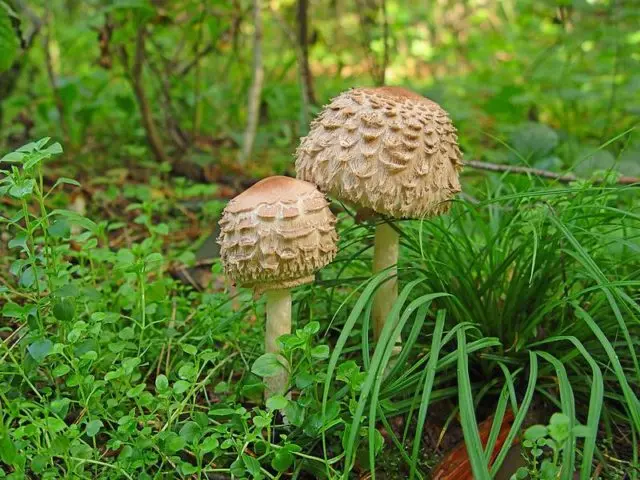
Umbrella blushing grows in open areas
What does a mushroom chicken coop look like?
Among the people, the blushing umbrella has gained its popularity as a “chicken coop” mushroom. This is due to the unusual shape of the young fruiting body. According to the descriptions and photos, the umbrella mushroom blushing, only slightly rising from the ground, is very similar to an egg with a cracked shell. In addition, according to many gourmets, the taste of this mushroom is strongly reminiscent of chicken meat.
The name “blushing umbrella mushroom” says a lot. With its appearance, it repeats the outlines of an umbrella, which opens in rainy weather, gently and carefully envelops its leg, protecting it from bad weather.
The difference between the reddening umbrella:
- The diameter of the cap is on average from 10 to 20 cm, the surface is scaly, the color is gray, smoothly turning into beige, the color darkens towards the center and becomes brown-brown.
- The structure of the pulp is loose. The cap is soft, the stem is fibrous. The pulp is initially white, turns red when damaged, and has no pronounced odor.
- The inner side has plates of white or slightly cream color.
- Another distinctive feature of chicken coop mushrooms are the so-called rings on the leg, somewhat reminiscent of snake skin.
- Spores are white, oval, smooth.
- The length of the stem is from 10 to 30 cm, the thickness, in some instances, reaches 5 cm. The color is beige or slightly brownish. There is a thickening at the base.
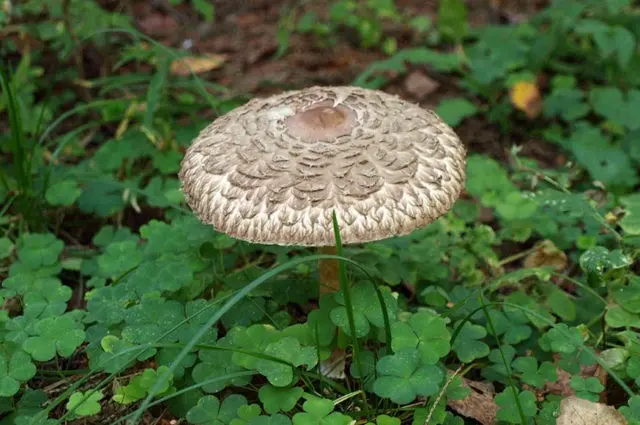
The cap can be up to XNUMX cm in diameter.
Chicken coop mushroom – edible or not
Shaggy umbrella mushroom (blushing) attracts with its exotic appearance and is considered one of the most delicious mushrooms, belongs to the conditionally edible group. The appearance is also not inferior to the taste characteristics. Despite the small popularity among mushroom pickers (due to the similarity with dangerous relatives), the chicken coop takes pride of place in the kitchens of many housewives. Basically, only the hats of the blushing umbrella are prepared. The legs are stiff, I rarely use them in cooking.
But still, along with the positive qualities and reviews, the umbrella mushroom also poses a certain threat to people with a sensitive digestive tract. The trace elements that make up the pulp can cause digestive upset when consumed raw or undercooked.
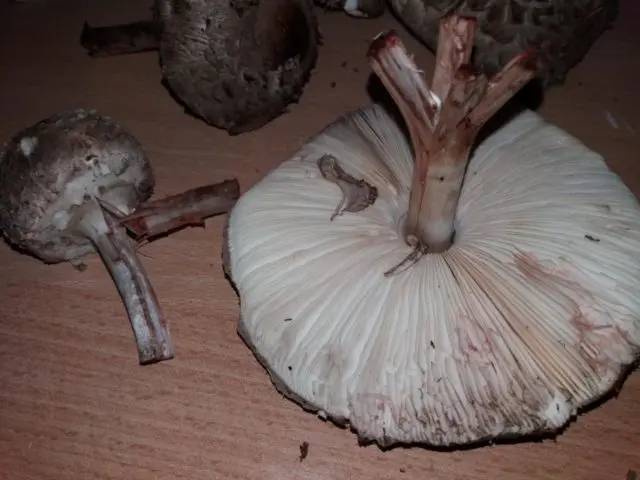
The blushing umbrella is considered edible
False twins of the blushing umbrella
The main reason for such a small popularity of the blushing umbrella is its resemblance to very dangerous and poisonous mushrooms. The main ones are: comb umbrella, chestnut lepiota, Morgan’s umbrella.
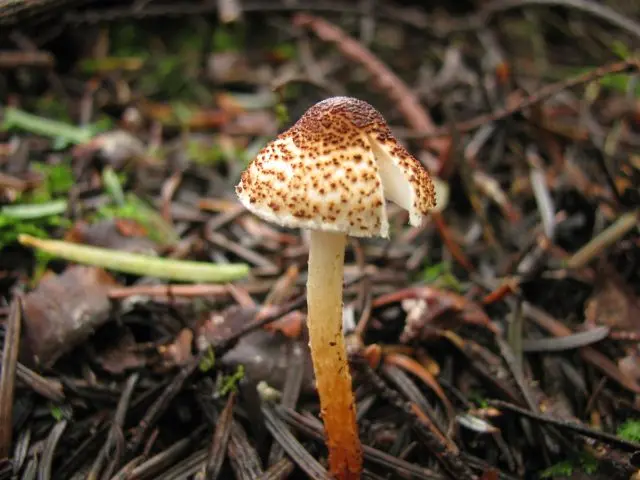
Lepiota chestnut
Most often, the blushing umbrella mushroom (Macrolepiotarhacodes) is confused with poisonous fly agaric and grebes. Even experienced mushroom pickers make mistakes.
First of all, you need to pay attention to:
- the shape and thickness of the leg;
- shade and pattern on the hat;
- coloring of the inner surface of the cap;
- texture and relief on the leg.
Also, not the last place in the list of dangerous doubles is occupied by the so-called false umbrellas. The species belong to the same family and it is often difficult to distinguish a poisonous specimen from an edible relative.
One of the most dangerous on this list is the comb umbrella. In young specimens, the hat is shaped like a small bell, as it grows, it becomes like a dome with a diameter of 12 to 15 cm. Its surface is reddish-brown or dark brown, covered with orange or pale yellow spiky scales. The leg is in the form of a cylinder, low, thin. In young mushrooms, a wide membranous ring is clearly visible, it is white or pink in color, but quickly disappears as it ripens. Unlike its edible counterpart, it has an unpleasant odor.
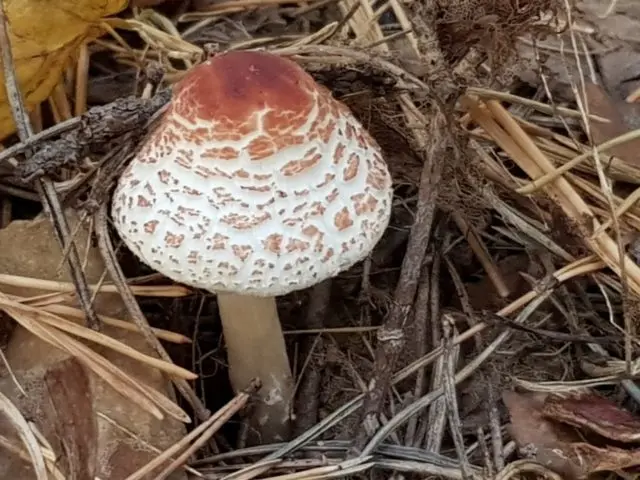
comb umbrella
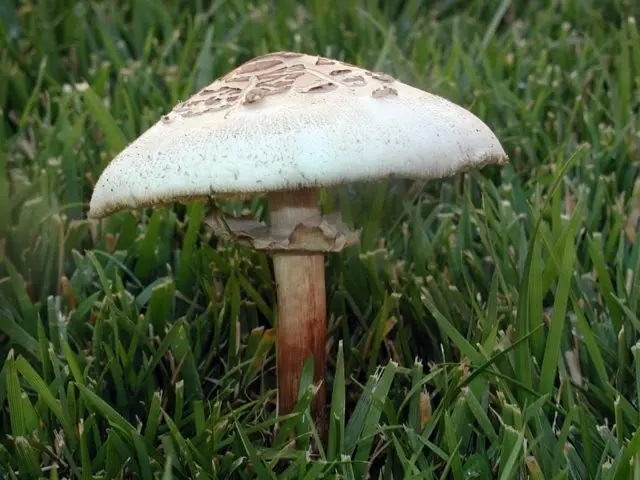
Morgan umbrella
Against the backdrop of all this wealth of species and classes, the main thing is not to get confused and not to get confused at the most necessary moment, to identify “friends among strangers”.
Rules for collecting a chicken coop
The season for collecting blushing umbrellas does not differ from others, as it coincides with the fruiting of most species and classes of mushroom families. In the forests, this fungus appears at the end of summer and is most common in September. This is considered to be the first wave of collection.
The second wave of fruiting is the month of October. The edible chicken coop, even directly at the time of harvest, has a typical light aroma. Experienced mushroom pickers know that you can find mushroom clearings not only in the forest, but also in clearings, plantings, and open spaces of pastures.
Redness at the cut point is a characteristic feature of the reddening umbrella, which helps the mushroom picker not to confuse it with other relatives of this species directly during harvesting.
How to cook chicken coop mushrooms
Mother nature gives a huge amount of benefits, demanding in return only a careful attitude. Each region is rich in different types of dishes, which, in the skillful hands of housewives, turn into gourmet dishes, individual culinary masterpieces. Mushrooms have always occupied an important place at the ceremonial table. And not in vain, because for all their availability and popularity, they contain a lot of A and B vitamins, trace elements and beneficial properties that have a beneficial effect on the body.
Chicken coop mushrooms can be prepared in a variety of ways.
There are several general preparation rules that apply to blushing umbrellas:
- clean from forest dirt;
- rinse under running water;
- dry, salt, boil.
Well, then a flight of fancy – fried, boiled, stewed, marinated, in batter, with and without sauce. There are many recipes for cooking chicken coop mushrooms. At the same time, each hostess strives to add her own zest to the dish.

There are many recipes for cooking mushrooms.
Conclusion
Reddening umbrella mushroom is a fairly easy prey. After all, it grows in large groups. And although many people know about its edibility, the similarity with poisonous species is alarming even for experienced mushroom pickers.









